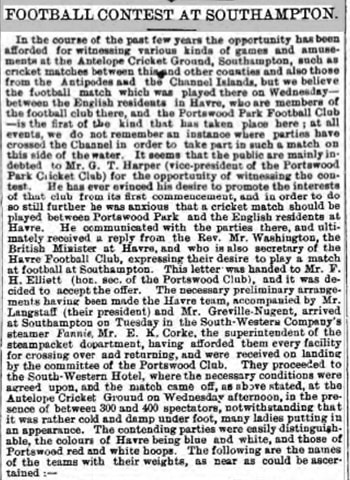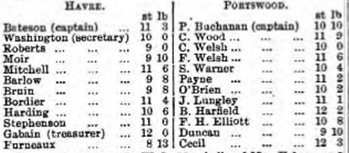It took place in Southampton on 19 February 1873, between Portswood Park and Le Havre. Thanks to detailed reports in the Hampshire Advertiser, which have recently become available thanks to the British Newspaper Archive, I have been able to piece together the story.
Portswood Park was originally a cricket club with a home at Abbot's Park, now better known as North Stoneham Park. The club was formed in 1867 as a successor to the Olympic Cricket and Athletic Club, and its members had played football in the winter months from about 1870. In those fledgling days of the sport, there was still much confusion about rules, and they played a kind of hybrid football that was neither association nor rugby.
As the newspaper makes clear, this particular match came about thanks to George Harper, a local ship owner, who originally proposed a cricket match with his contacts in Le Havre. The reply came back from Rev George Washington that they would rather play football, and the clubs agreed to play the game.
It was quite a venture for the visitors, who travelled by steamer on the Tuesday from Le Havre to Southampton, and booked into the South-Western Hotel. There, they agreed the arrangements of the game with their hosts, including the rules and the number of players.
On Wednesday afternoon the match drew a crowd of 3-400 spectators, including 'many ladies', to the Antelope Ground in Southampton. This was the home of Hampshire County Cricket Club and later the home ground of Southampton FC until 1897.
At this distance in time it is hard to work out what rules the teams were playing to, or the origins and influences which led to this form of football. Even the scoring system requires some scrutiny as the reporter appears to have confused touchdowns and rouges. A touchdown, as in rugby, gave the opportunity to kick for goal over the posts and historically this is similar to the rouge, a term from the Eton field game and also used in Sheffield football.
The teams enjoyed a marvellous dinner that evening at the Philharmonic Rooms and the visitors were entertained by numerous speeches and toasts. The visitors then returned to the docks at midnight for the return journey to France. Despite every best intention of arranging a return match in the coming months, it never happened and the game remained a one-off.
Portswood Park had only a short life as a club thereafter and appears to have stopped playing cricket in 1874. Le Havre, on the other hand, went from strength to strength and Havre Athletic Club became a successful multi-sport club including teams playing both association and rugby football.
Given the nature of the football they played in 1873, this match is difficult to categorise and it will not find a place in the histories of rugby or association football. Yet it was 'football' of a sort, and indicates that innovative sporting contacts were feasible outside the usual framework of established clubs and schools.
The Portswood Park team is easier to identify, as they were mainly middle class professionals at the start of their careers as solicitors, clerks and shipping agents. Most of them also played cricket and took part in local athletics meetings.
Team captain was Peter Vosper Buchanan, a clerk who later emigrated to New Zealand. The others were: Caleb Joshua Wood, a clerk; brothers Charles Roberts Welsh, still at school, and Frank James Tizard Welsh, a brewer; Sidney Gater Warner, trainee solicitor; Arthur George Payne, son of Southampton's mayor; Lucius Melville O'Brien, trainee solicitor; James Lungley, son of a local shipowner; Bernard Harfield, a clerk; Frank Henly Elliott, slate merchant; Dunbar Wilson Johnston Duncan, who later played cricket for Hampshire; and the goalkeeper identified only by his surname Cecil, possibly one of the brothers Aubrey or Egerton Cecil, who also played cricket for Hampshire.
Others mentioned include the club president, Councillor John Neat Pocock, and vice-president George Thomas Harper. Tickets were sold at the High Street shop of Thomas Dartnall, who also provided the catering.
As for Havre Football Club, the most prominent player was Reverend George Washington (1835-1906), resident minister in Le Havre, who had been educated at Winchester College and Cambridge University, hence he probably had a good football background. The only other player I can identify with certainty is Charles Edward Gabain, the club treasurer and a wealthy coffee importer.
The remaining Havre players were Bateson, Roberts, Moir, Mitchell, Barlow, Bruin, Bordier, Harding, Stephenson and Furneaux. From the names, most of them were British but they do seem to include two or three Frenchmen.



 RSS Feed
RSS Feed